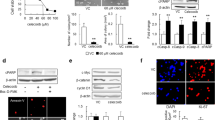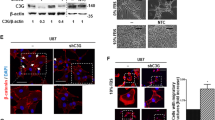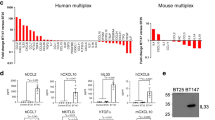Abstract
Glioblastoma multiforme is a highly invasive tumor bearing a dismal prognosis. Experimental strategies that focus on the specific biological cues governing the invasive capacity of these tumors may hold significant therapeutic promise. In this context, we describe the in vitro and in vivo association of the cell surface chemokine receptor, CXCR4, with the development of an invasive phenotype in malignant glioblastoma. We demonstrate that invasive populations of glioma cells overexpress CXCR4 at the message and protein levels, and that this expression ranges from 25- to 89-fold higher than that found in noninvasive tumor cells. Furthermore, neutralization of CXCR4 significantly impairs the in vitro invasive capacity of malignant glial cells. In addition, glioma cells secrete CXCL12 and demonstrate robust invasive capacity toward a CXCL12 gradient in vitro. These findings underscore the importance of CXCR4 as a potential therapeutic target for the treatment of invasive glioblastoma.
This is a preview of subscription content, access via your institution
Access options
Subscribe to this journal
Receive 50 print issues and online access
$259.00 per year
only $5.18 per issue
Buy this article
- Purchase on Springer Link
- Instant access to full article PDF
Prices may be subject to local taxes which are calculated during checkout



Similar content being viewed by others
References
Barbero S, Bonavia R, Bajetto A, Porcile C, Pirani P, Ravetti JL et al. (2003). Cancer Res 63: 1969–1974.
Bartolome RA, Galvez BG, Longo N, Baleux F, Van Muijen GN, Sanchez-Mateos P et al. (2004). Cancer Res 64: 2534–2543.
Belperio JA, Phillips RJ, Burdick MD, Lutz M, Keane M, Strieter R . (2004). Chest 125: 156S.
Coleman MT, Allred LE, Hart RW, Yates AJ . (1980). Cancer Lett 8: 255–262.
Ehtesham M, Kabos P, Gutierrez MA, Samoto K, Black KL, Yu JS . (2003). J Immunother 26: 107–116.
Ehtesham M, Samoto K, Kabos P, Acosta FL, Gutierrez MA, Black KL et al. (2002). Cancer Gene Ther 9: 925–934.
Fernandis AZ, Prasad A, Band H, Klosel R, Ganju RK . (2004). Oncogene 23: 157–167.
Helbig G, Christopherson II KW, Bhat-Nakshatri P, Kumar S, Kishimoto H, Miller KD et al. (2003). J Biol Chem 278: 21631–21638.
Huber MA, Azoitei N, Baumann B, Grunert S, Sommer A, Pehamberger H et al. (2004). J Clin Invest 114: 569–581.
Lakka SS, Gondi CS, Yanamandra N, Olivero WC, Dinh DH, Gujrati M et al. (2004). Oncogene 23: 4681–4689.
Lakka SS, Rajan M, Gondi C, Yanamandra N, Chandrasekar N, Jasti SL et al. (2002). Oncogene 21: 8011–8019.
Liang Z, Yoon Y, Votaw J, Goodman MM, Williams L, Shim H . (2005). Cancer Res 65: 967–971.
Mori T, Doi R, Koizumi M, Toyoda E, Ito D, Kami K et al. (2004). Mol Cancer Ther 3: 29–37.
Muller A, Homey B, Soto H, Ge N, Catron D, Buchanan ME et al. (2001). Nature 410: 50–56.
Oh JW, Drabik K, Kutsch O, Choi C, Tousson A, Benveniste EN . (2001). J Immunol 166: 2695–2704.
Orimo A, Gupta PB, Sgroi DC, Arenzana-Seisdedos F, Delaunay T, Naeem R et al. (2005). Cell 121: 335–348.
Rubin JB, Kung AL, Klein RS, Chan JA, Sun Y, Schmidt K et al. (2003). Proc Natl Acad Sci USA 100: 13513–13518.
Singh S, Singh UP, Grizzle WE, Lillard Jr JW . (2004). Lab Invest 84: 1666–1676.
Strieter RM . (2001). Nat Immunol 2: 285–286.
Surawicz TS, Davis F, Freels S, Laws Jr ER, Menck HR . (1998). J Neurooncol 40: 151–160.
Wong AS, Gumbiner BM . (2003). J Cell Biol 161: 1191–1203.
Woo JH, Park JW, Lee SH, Kim YH, Lee IK, Gabrielson E et al. (2003). Cancer Res 63: 3430–3434.
Yu JS, Wheeler CJ, Zeltzer PM, Ying H, Finger DN, Lee PK et al. (2001). Cancer Res 61: 842–847.
Zeelenberg IS, Ruuls-Van Stalle L, Roos E . (2003). Cancer Res 63: 3833–3839.
Zhang J, Sarkar S, Yong VW . (2005). Carcinogenesis (published online).
Zhou Y, Larsen PH, Hao C, Yong VW . (2002). J Biol Chem 277: 49481–49487.
Acknowledgements
This work was supported in part by NIH grant NS051557 to M. Ehtesham.
Author information
Authors and Affiliations
Corresponding author
Rights and permissions
About this article
Cite this article
Ehtesham, M., Winston, J., Kabos, P. et al. CXCR4 expression mediates glioma cell invasiveness. Oncogene 25, 2801–2806 (2006). https://doi.org/10.1038/sj.onc.1209302
Received:
Revised:
Accepted:
Published:
Issue Date:
DOI: https://doi.org/10.1038/sj.onc.1209302
Keywords
This article is cited by
-
Anticancer Effects of AKBA on Glioblastoma Cancer Cells Through Modulating TWIST1 and FOXM1 Expression Levels
Iranian Journal of Science and Technology, Transactions A: Science (2021)
-
Imaging CXCR4 Expression with Iodinated and Brominated Cyclam Derivatives
Molecular Imaging and Biology (2020)
-
Gefitinib promotes CXCR4-dependent epithelial to mesenchymal transition via TGF-β1 signaling pathway in lung cancer cells harboring EGFR mutation
Clinical and Translational Oncology (2020)
-
Tropism of mesenchymal stem cell toward CD133+ stem cell of glioblastoma in vitro and promote tumor proliferation in vivo
Stem Cell Research & Therapy (2018)
-
Maxillary calcifying epithelial odontogenic tumor with sinus and buccal vestibule extension: a case report and immunohistochemical study
Diagnostic Pathology (2016)



